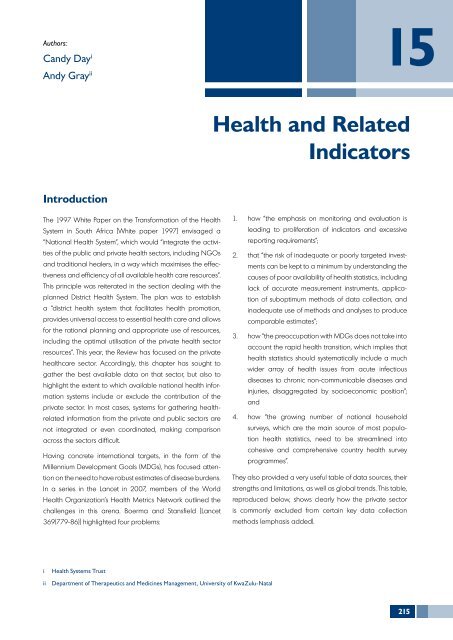SAHR 2007 - Health Systems Trust
SAHR 2007 - Health Systems Trust
SAHR 2007 - Health Systems Trust
Create successful ePaper yourself
Turn your PDF publications into a flip-book with our unique Google optimized e-Paper software.
Authors:<br />
Candy Day i<br />
Andy Gray ii<br />
15<br />
<strong>Health</strong> and Related<br />
Indicators<br />
Introduction<br />
The 1997 White Paper on the Transformation of the <strong>Health</strong><br />
System in South Africa [White paper 1997] envisaged a<br />
“National <strong>Health</strong> System”, which would “integrate the activities<br />
of the public and private health sectors, including NGOs<br />
and traditional healers, in a way which maximises the effectiveness<br />
and efficiency of all available health care resources”.<br />
This principle was reiterated in the section dealing with the<br />
planned District <strong>Health</strong> System. The plan was to establish<br />
a “district health system that facilitates health promotion,<br />
provides universal access to essential health care and allows<br />
for the rational planning and appropriate use of resources,<br />
including the optimal utilisation of the private health sector<br />
resources”. This year, the Review has focused on the private<br />
healthcare sector. Accordingly, this chapter has sought to<br />
gather the best available data on that sector, but also to<br />
highlight the extent to which available national health information<br />
systems include or exclude the contribution of the<br />
private sector. In most cases, systems for gathering healthrelated<br />
information from the private and public sectors are<br />
not integrated or even coordinated, making comparison<br />
across the sectors difficult.<br />
Having concrete international targets, in the form of the<br />
Millennium Development Goals (MDGs), has focused attention<br />
on the need to have robust estimates of disease burdens.<br />
In a series in the Lancet in <strong>2007</strong>, members of the World<br />
<strong>Health</strong> Organization’s <strong>Health</strong> Metrics Network outlined the<br />
challenges in this arena. Boerma and Stansfield [Lancet<br />
369(779-86)] highlighted four problems:<br />
1. how “the emphasis on monitoring and evaluation is<br />
leading to proliferation of indicators and excessive<br />
reporting requirements”;<br />
2. that “the risk of inadequate or poorly targeted investments<br />
can be kept to a minimum by understanding the<br />
causes of poor availability of health statistics, including<br />
lack of accurate measurement instruments, application<br />
of suboptimum methods of data collection, and<br />
inadequate use of methods and analyses to produce<br />
comparable estimates”;<br />
3. how “the preoccupation with MDGs does not take into<br />
account the rapid health transition, which implies that<br />
health statistics should systematically include a much<br />
wider array of health issues from acute infectious<br />
diseases to chronic non-communicable diseases and<br />
injuries, disaggregated by socioeconomic position”;<br />
and<br />
4. how “the growing number of national household<br />
surveys, which are the main source of most population<br />
health statistics, need to be streamlined into<br />
cohesive and comprehensive country health survey<br />
programmes”.<br />
They also provided a very useful table of data sources, their<br />
strengths and limitations, as well as global trends. This table,<br />
reproduced below, shows clearly how the private sector<br />
is commonly excluded from certain key data collection<br />
methods (emphasis added).<br />
i<br />
<strong>Health</strong> <strong>Systems</strong> <strong>Trust</strong><br />
ii Department of Therapeutics and Medicines Management, University of KwaZulu-Natal<br />
215
















